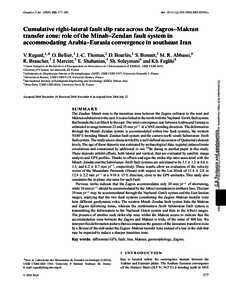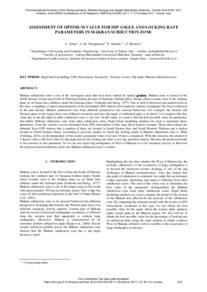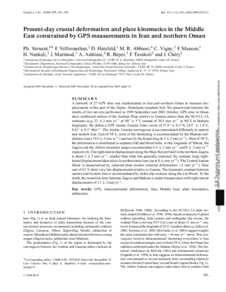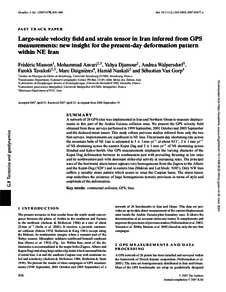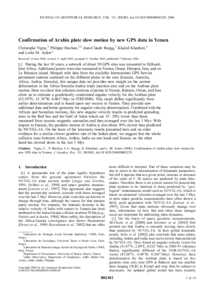Document
Cumulative right-lateral fault slip rate across the Zagros-Makran transfer zone : role of the Minab-Zendan fault system in accommodating Arabia-Eurasia convergence in southeast Iran.
Identifier
DOI: 10.1111/j.1365-246X.2005.02558.x
Source
Geophysical Journal International. v. 162, 1, p. 177-203
Contributors
Bellier, O. , Author
Thomas, J. C., Author
Bourles, D., Author
Bonnet, S., Author
Abbassi, M. R., Author
Braucher, R., Author
Mercier, J., Author
Shabanian, E., Author
Soleymani, Sh., Author
Feghhi, Kh., Author
Country
United Kingdom.
City
London.
Publisher
RAS.
Gregorian
2005-07-01
Language
English
English abstract
The Zendan-Minab zone is the transition zone between the Zagros collision to the west and Makran subduction to the east. It is also linked to the north with the Nayband-Gowk fault system that bounds the Lut Block to the east. The total convergence rate between Arabia and Eurasia is estimated to range between 23 and 35 mm yr-1 in a NNE-trending direction. The deformation through the Minab-Zendan system is accommodated within two fault systems, the western N160°E-trending Minab-Zendan fault system and the eastern north-south Sabzevaran-Jiroft fault system. The study area is characterized by a well-defined succession of Quaternary deposit levels. The age of these deposits was estimated by archaeological data, regional palaeoclimate correlations and constrained by additional in situ 10Be dating in another paper in this study. These deposits exhibit offsets, both lateral and vertical, that are evaluated by satellite image analysis and GPS profiles. Thanks to offsets and ages the strike-slip rates associated with the Minab-Zendan and the Sabzevaran-Jiroft fault systems are calculated to be 5.1 ± 1.3 or 6.6 ± 1.5, and 6.2 ± 0.7 mm yr-1, respectively. These results allow an evaluation of the velocity vector of the Musandam Peninsula (Oman) with respect to the Lut Block of 11.4 ± 2.0 or 12.9 ± 2.2 mm yr-1 in a N10 ± 15°E direction, close to the GPS estimates. This study also constrains the in-plane slip rates for each fault. Previous works indicate that the Zagros accommodates only 10 mm yr-1 of shortening, while 10 mm yr-1 should be accommodated by the Alborz mountains in northern Iran. This last 10 mm yr-1 may be accommodated through the Nayband-Gowk system and the East Iranian ranges, implying that the two fault systems constituting the Zagros-Makran transfer zone have different geodynamic roles. The western Minab-Zendan fault system links the Makran and Zagros deforming zones, whereas the northwestern Jiroft-Sabzevaran fault system is transmitting the deformation to the Nayband-Gowk system and then to the Alborz ranges. The presence of another such strike-slip zone within the Makran seems to indicate that the accommodation zone between the Zagros and Makran is wide, of the order of 400 km. We interpret this deformation pattern that accompanies the genesis of the immature transform zone by a flexure of the stab under the Zagros-Makran transfer zone instead of a tear in the slab that may be expected to induce a sharper transition zone.
ISSN
0956-540X
Category
Journal articles

